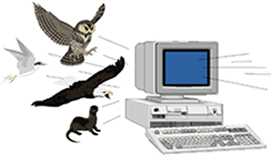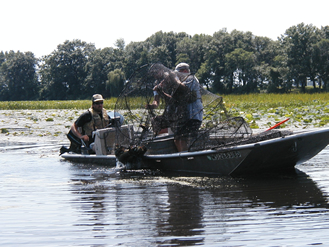- Home
- About S&T
- Taxa/Organisms
- Ecosystems
- Issues
- Methods & Tools
- Reports & Publications
- Location
- Search
Publisher: USGS | Science Center: Leetown Science Center (LSC, Kearneysville) | Format: URL
www.lsc.usgs.gov — This is a research project whose primary objective is to assess the health of selected fish species (brown bullhead and largemouth bass) and compare these findings with historic information on fish health in the individual rivers and with concurrent samples collected at reference sites. A secondary objective is to compare and correlate the fish More...

Publisher: USGS | Science Center: Patuxent Wildlife Research Center (PWRC, Laurel) | Format: URL
www.pwrc.usgs.gov — This research project gives an overview of the hormonal control and the effects of endocrine-active contaminants on avian secondary sex characteristics. This project will develop measures for plumage, soft parts (bill and dermal structures) color and pattern in American kestrels (Falco sparverius). In addition, experiments will characterize the More...

Publisher: USGS | Science Center: Leetown Science Center (LSC, Kearneysville) | Format: URL
www.lsc.usgs.gov — This research project measures the effects of estrogen and related contaminants on the expression of genes involved in the innate immune system of fish in rivers of the Chesapeake Bay Drainage. This project begs the question of whether or not hepcidin are expression and iNOS expression induced upon exposure to bacteria, and whether this induction More...

Publisher: USGS | Science Center: Columbia Environmental Research Center (CERC, Columbia) | Format: URL
www.cerc.usgs.gov — This research project objective is to measure vtg and steroid hormones in sexually mature, adult razorback sucker over one annual -estradiol,ß reproductive cycle. We will measure vtg and steroid hormones (17 11-ketotestosterone, and testosterone) in blood plasma of razorback suckers once a month for one year to document concentrations throughout More...

Publisher: USGS | Science Center: Patuxent Wildlife Research Center (PWRC, Laurel) | Format: URL
www.pwrc.usgs.gov — BEST Large River Fish Health Data Query Tool provides a simplified portal for accessing database that serves fish health endpoints measured through the Biomonitoring of Environmental Status and Trends (BEST) Project's Large River Monitoring Network (LRMN). The tool allows the user to search the database by species, chemical, river basin, sampling More...

Publisher: USGS | Science Center: Forest and Rangeland Ecosystem Science Center (FRESC, Corvallis) | Format: URL
ris.wr.usgs.gov — The Raptor Information System (RIS) is a computerized literature retrieval system that focuses on raptor management, human impacts on raptors, the mitigation of adverse impacts, and basic raptor biology (with an emphasis on population dynamics and predation). The raptor contaminants database is a subset of RIS that includes references with More...

Publisher: USGS | Science Center: Upper Midwest Environmental Sciences Center (UMESC, LaCrosse) | Format: URL
www.umesc.usgs.gov — This web resource provides decision makers with the information needed to maintain the Upper Mississippi River System as a viable multiple-use large river ecosystem. This resource also includes Data and sampling information, publication links, reports, other related documents and statistics, as well as links to field stations and other projects More...

Publisher: USGS | Science Center: Patuxent Wildlife Research Center (PWRC, Laurel) | Format: URL
www.pwrc.usgs.gov — Information about ecotoxicological exposure and its effects on terrestrial vertebrates residing in estuarine and coastal habitats like the Atlantic, Gulf and Pacific Coasts, Alaska and Hawaii, as well as the Great Lakes. These vertebrates include birds, mammals, amphibians and reptiles. The data is a compilation of results from computerized More...

Publisher: NBII | Format: URL
pollinators.nbii.gov — The global declines in many kinds of pollinator species could potentially impact the global food supply, as many plants depend upon specific pollinators to reproduce. The Web site of the NBII Pollinators Project provides access to information about the biology, ecology, conservation status, and threats to native pollinators, pollinator-dependent More...

September 2008 | Publisher: USGS | Format: URL
pubs.usgs.gov — Water is among Florida's most valued resources. The State has more than 1,700 streams and rivers, 7,800 freshwater lakes, 700 springs, 11 million acres of wetlands, and underlying aquifers yielding quantities of freshwater necessary for both human and environmental needs (Fernald and Purdum, 1998). Although renewable, these water resources are More...

2008 | Publisher: USGS | Science Center: Western Ecological Research Center (WERC, Sacramento) | Format: .PDF
www.werc.usgs.gov — Mercury is a contaminant of significant concern in waterbirds because it can accumulate to high concentrations in their tissues and cause deleterious effects such as impaired reproduction. Numerous studies and monitoring programs have evaluated concentrations of mercury in waterbird tissues as an index of risk to exposure. However, no single More...

2008 | Publisher: Other (RSC Publishing, Journal of Environmental Monitoring) | Format: URL
www.rsc.org — Environmental contaminant and biomarker monitoring data from major U.S. river basins were summarized for black bass (Micropterus spp.) and common carp (Cyprinus carpio) sampled over a nine year period. Cumulative frequency distributions revealed taxon differences for many organochlorine residue concentrations, elemental contaminant concentrations, More...
